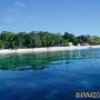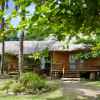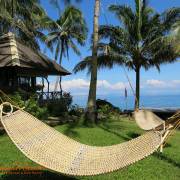Dive in Mindanao
-
Agutayan Island Mindanao, Philippines
One of the underwater jewels of Mindanao is the diving spots in NorthernMindanao, specifically the waters surrounding the Agutayan Island knownas Agutayan Marine Sanctuary, off the coast of Jasaan, MisamisOriental. The island, virtually a sandbar is surrounded by green watersthat is rich with marine… -
Bulias Shoal Camiguin, Philippines
balck corals, manta rays (depending on season), barracudas, jacks... -
Coral Garden Camiguin Camiguin, Philippines
Soft and hard corals, sea snakes,mandarin fish at night fall. -
Jigdup Reef Camiguin, Philippines
Reef slope down to 30m deep. Black corals, large sponges, mantas (in season), frog fish, Hawkbill turtles... -
Jigdup Wall Camiguin, Philippines
Great wall from 6 to 45m deep; some small caves and a lot of fish shoals! Barracudas, fusillers, snappers, jacks... -
Kabila Camiguin, Philippines
Reef slope -
Mantigue Island Camiguin, Philippines
Small caves and short walls. Rabbit fishes, Turtles, barracudas... -
Old Volcano Camiguin, Philippines
Sharp pinnacles formed by the volcano lava. Great marine life including soft corals, Pygmy Seahorse, Ghost Pipefish, Batfish, Garden Eels, White tip Sharks, and Frogfish. Unexpected Manta & Eagle Rays! -
Sunken Yatch Camiguin, Philippines
Sandy/muck dive area -
Tangub Hot Springs Camiguin, Philippines
Dark sand terraces with great soft corals. The hot spring is not underwater but located on the shoreline. -
White Island Black Forest Camiguin, Philippines
Black corals 'forest' on white sand with stingrays! -
White Island reef Camiguin, Philippines
-
Volcan Beach House Reef Camiguin, Philippines
sandy, soft and hard corals, a lot of macro, Anemone fishes, moray and ribbon eels, cuttle fish, octopus, Trigger fish, sea snakes, barracuda, turtle.... -
Gipsy Rover Camiguin, Philippines
sandy bottom, sea grass, wreckdifferent Lion fishes at the wreck, scorpion fish, bat fish, School of fusiliers, ghostpipefish, garden eels, ribbon eels, frog fish, leaf fishes -
Tango Bay Camiguin, Philippines
steep slope, calm dive, ghostpipe fish, frog fish, leaf fish, sea horses, different shrimps and crabs, Anemone fishes... -
Blue Cathedral Camiguin, Philippines
The architecture of the rock formations, add to the amazing visibility and the light, make it unik!The entrance is a hole at 14 m deep, of approx 20 m diameter.The slope goes down slowly; a first gate on the left (22 m to 30m) and than the main tunnel, the Blue Cathedral: approx 50 m long, 10 m… -
Angels Cove Davao, Philippines
Large tunas, mackerels and jack. Good soft and hard corals. -
Coral Garden Davao Davao, Philippines
Sandy slope with good hard & soft corals. Eels, parotfish, napoleon... -
Isla Reta Davao, Philippines
-
Ligid Caves Davao, Philippines
Very nice caves including black corals. Some sharks may be seen around. -
Mansoud Wall Davao, Philippines
Great tunicates fixed to the wall. -
Marissa Davao, Philippines
Good corals and marine life. Hawksbill turtles may be seen here. -
Tinoto Wall Sarangani Bay Islands, Philippines
-
Liuay Rock Dakak Island, Philippines
A low dive, sloping bottom, and a good selection of invertebrates, especially soft corals. Unusual nudibranchs and several species of starfish. Good for novices for general poking around. Ideal for check-out dives. -
The Caves Dakak Island, Philippines
Striking walls drop to an average of 60 degrees where there is a sandy bottom and a series of caves occupied by sweepers, soldier fish, puffer fish, and sea plumes. Some nice bushes of black coral are seen here. Night diving is impressive with Spanish dancers, sleeping fish and a wide diversity of… -
Mushrom Wall Dakak Island, Philippines
At only 10 ft, the shallow roof area turns to a nice wall with fan corals, encrusting sponges, crevices, small ledges and dramatic undercuts, bottoming out at 60 feet. Huge scraps of hard corals (Stag horn, lettuce leaf) with thousands of reef fish separate Mushroom Wall from "The Caves" on its end… -
The Gardens Dakak Island, Philippines
A sequence of coral gardens, small walls, sandy area with coral heads and slopes with soft corals. Plenty of anthias, hawk fish, and invertebrates. Good for snorkeling and for trainee or beginner in diving. -
Cesar's Reef Dakak Island, Philippines
Tiny reef area with bounded coral covers. Rich with large fish such as napoleon wrasses (Chiefly tropical marine fishes with fleshy lips and powerful teeth; usually brightly colored), tuna and parrot fish. View schools of surgeon fish, barracuda (Any voracious marine fish of the genus Sphyraena… -
The Wreck Dakak Island, Philippines
Seven year old sunken passenger liner with bottom depth of 180 feet, and 130 feet at its highest point. Big schools of fish from deck such as black and white snappers, red snapper, jacks, and groupers. Great visibility. For adventurous, experienced divers. -
Octopus Wall Dakak Island, Philippines
Small wall with pretty growth, octopuses, scorpion fish, sponges, tubastrea, continuous into a slope to the north with some strange crinoids covered formations provide a very scenic view of rudderfish, groupers, etc. -
Buchok's Reef Dakak Island, Philippines
A series of large coral mounds with nice selection of marine life: giant reef rays, small white tip sharks, unicorn surgeons, snappers and sweetlips. For experienced divers only. -
Challenger Reef Dakak Island, Philippines
The reef area is almost half the size of Aligua, its top is about 125 feet deep, with soft coral growth. The northern part of the island has short walls and a long narrow opening and a few juvenile fish. -
Romy's Reef Dakak Island, Philippines
Plenty of coral mounds, with enormous basket sponges, a fine and nice selection of reef fish and invertebrates. Sightings have been reported of blue spotted rays and a few turtles. Some coral damage and unfruitful areas though; eastern area though has massive coral thickets and extends through to… -
Eskuelahan Dakak Island, Philippines
Named for the numerous schools of fish (snappers, jacks, rainbow runners, surgeons, etc) and occasional tuna found in the area. It is a center of activity with fish of all sizes feeding. Giant frog fish have been also sighted. Currents may be a problem for novice divers.





